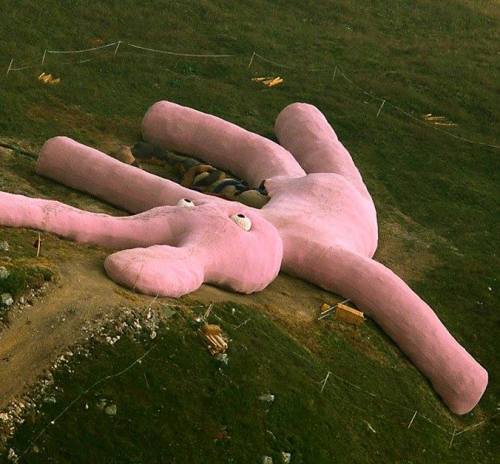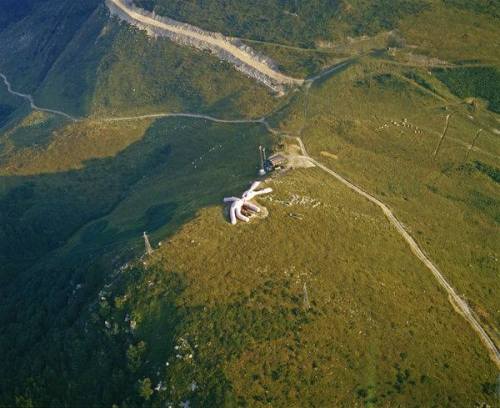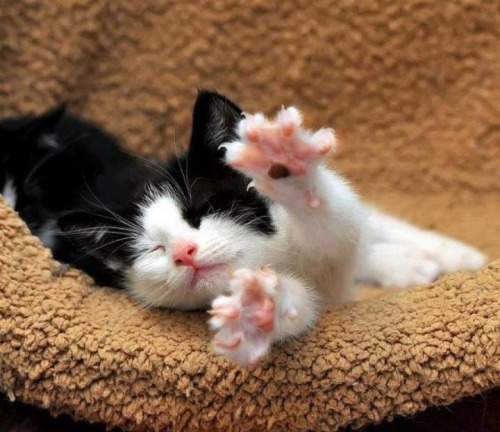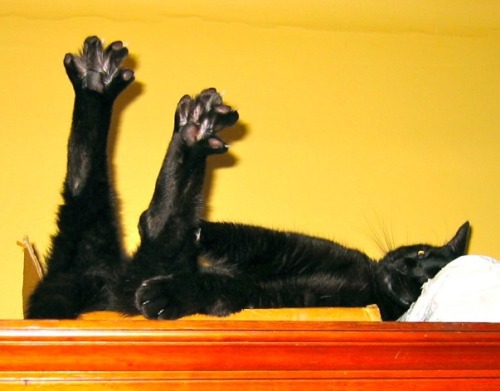Trying To Impress Cats And Failing Is Universal
Trying to impress cats and failing is universal
(via)
More Posts from Linruuu and Others
on days where you’re in pain and seemingly haunted by shadows and overcast thoughts, be gentle and overtly kind to yourself. remember moments where you’ve felt unbridled bliss, with cotton candy and honey coursing through your veins as dripping golden skies illuminated your wondrous, bright life. one day, you’ll embrace that warmth and pure joy time and time again. take small steps, be patient and embrace your kaleidoscope of emotions, tending to them whether they are brimming with dark hues or coated in light. take care, balance and bloom.


In 2005, a group of artists in Italy built a giant 200-foot-long plushie rabbit in the countryside, and just left it there. It’s been there ever since.
(Source)
He’s coming to boop you
nah bro YOU live in a society. i live in a hole in the ground. not a nasty, dirty, wet hole with the ends of worms and an oozy smell, nor yet a dry, bare, sandy hole with nothing in it to sit down on or to eat: it was a hobbit-hole, and th
Hey just an idea but maybe instead of pushing veganism or vegetarianism on everyone in our society, we re-evaluate our society’s entire lifestyle and make changes to our individual lifestyles based on that because let’s be real: traditional veganism is not any better for the environment or physically healthier than eating animals products if you’re not doing your due diligence. By being conscientious about where all the products you buy are sourced, you can have a bigger positive impact than simply going vegan.
If you’re:
Eating sustainably/carbon negative farmed meat and/or hunting your own meat, and only eating wild caught fish
Not using sea salt due to its microplastics
Not using products containing palm oil
Eating your own cultivated organic fruit and vegetables or purchasing organic fruit/veggies
Buying honey from local beekeepers as well as having solitary bee hotels around your neighborhood
Not buying new plastic or reusing and recycling that little plastic you inevitably still have
Not purchasing brand new electronics unless 100% necessary
Buying leather or suede second hand instead of purchasing PU leather, and in general trying to purchase second hand clothes rather than buying new
Mostly using cheese and milk from a variety of animals that have lower carbon emissions than cows, ie Sheep and Goat milk
Participating in a city wide composting scheme so your food waste doesn’t go into the landfill and end up producing methane
Donating to lobbyist groups that advocate for the elimination of non-recyclable and non-compostable plastics as well as for the elimination of pesticides and toxic fertilizers
Reducing your carbon footprint by only using public transport or an electric/hybrid car
Collecting rainwater when possible
Choosing not to embalm when burying passed loved ones
Buying or making your own biodegradable soaps instead of purchasing soaps with pollutants and microplastics
Tending to eat local/native grains instead of buying grains from far away places where labor is cheap, and the nutritious food (quinoa for example) is exported rather than eaten by locals
Buying second hand furniture or only purchasing furniture that is made of solid wood and eco friendly materials instead of buying laminate and plastic furniture
Buying bamboo toothbrushes and hairbrushes instead of plastic ones
Buying personal items like bedding and underwear and sneakers and you opt for bamboo based materials instead of polyester, this goes for your mattress as well since you can buy bamboo based foam mattresses
Picking up litter you see on the street
Not smoking cigarettes due to the plastic in them nor vaping from single use cartridges
Volunteering for community wide eco-education
Doing any other eco-friendly lifestyle choice not mentioned...
... You are making a bigger impact on the world than anyone choosing to make a single change to their lifestyle like going vegan. Becoming carbon neutral and making choices that encourage carbon neutrality makes more of a difference than one single lifestyle change. Switching to an electric vehicle is meaningless if you still buy from companies using herbicides and pesticides. Eating organic is still not good enough if you let your food go to waste in a landfill. Choosing locally sourced honey over agave makes a difference (supporting small beekeepers will help maintain local bee populations). Choosing locally hunted meat over quinoa for protein makes a difference (deer populations have grown exponentially due to smaller wolf populations, and you can help your local ecology by hunting and eating them or buying from local deer hunters) but make sure that that is the right choice for you. Furthermore, something you would think is silly and unimportant, like buying wild caught fish instead of inorganic tofu can actually make a difference. Every choice you make has an impact and/or consequences. Unfortunately, it’s sometimes hard to know which choice is best, especially because we have so much misinformation on how to make the right choices. The only solution therefore, is to learn about your community and the environment in which you live. Educating oneself on which choices are best for themselves and their community’s lifestyle is something that very few people will ever take the time to do, even though it is something we really need to start doing. Buying organic fresh fruit and veg may be good for a community living in a perennially warm environment, but if you’re in a colder climate, in winter, when berries are out of season, buying organic fruits and veg might not be the best option since they’re likely to be imported via airplanes not only contributing to carbon emissions but also, they are likely to be much more expensive and unaffordable to the majority of the community. Similarly, in some parts of the world, cows milk might be the most affordable and environmentally friendly milk option, while in another part of the world, goat or sheep’s milk might be the more environmentally friendly and affordable option (side note: almond milk is almost universally never environmentally friendly, soy milk is really quite bad for you, so please choose organic rice (almost never brown rice though due to the high amounts of arsenic) or organic oat milk if you cannot have regular milk. Bonus enviro points to you if you make your own oat or rice milk btw!). So, do your research and then: use your spare time to educate your community and spread your new knowledge about how to make good ecological and health choices, call friends and family out if you see them littering or doing something wasteful, do what you can with your money to support local companies being proactively environmentally friendly, and use the power of your vote to support policies and politicians that will eventually force stagnant industries and corporations to become at the least: carbon neutral.
Dm me if you want some more interesting enviro food facts btw! There’s a whole arsenal of knowledge that I can give you!
Have fun learning to change the world folks!!









SOMETHING TO SNOUT ABOUT
you’re wandering across the plains of Mongolia, wondering where the fuck you left your horse. suddenly, the ground shakes! like the beginning of the stampede scene in the Lion King. you hear a distant thunder, as if caused by many hooves! like the stampede scene in the Lion King. you shift anxiously as the noise grows louder, wishing you’d paid more attention to the Disney classics.
suddenly the herd comes over the rise, and you laugh so hard you fall over and are immediately and tragically trampled to death.
surprise! it’s the-


and it’s rude to laugh. (but boy, is it hard not to.)
the Saiga (sigh-guh) is a goat-sized antelope native to the Eurasian steppe. they’re found from the Carpathian Mountains to Mongolia. and they uh, have a bit of a nose situation going on.
and that’s the understatement of the century! the Saiga’s mighty schnozz is its defining feature, and no other hooved animal on earth has such a robust snoot. the Saiga pities their pathetic little faces for it.

that’s a lot of nose to look down. geeze.
so why this immense not-quite-trunk? maybe they use it to make noise, or to intimidate rivals? not so much, actually. both males and females have the tremendous facetrumpet, though females do lack horns and a desire to kill. (but more on that later.)
obviously this big ol clown honker must have some purpose, or it wouldn’t exist. or maybe God was just bored, who nose. (har!) but I kid, this punderful snout actually does have a purpose!

and that purpose is to look ABSOLUTELY STUNNING.
as I mentioned, Saigas are herd animals. and at some point, Evolution decided to provide them with a semi-helpful wedgie. that monster snout helps to filter dust kicked up by their 50ish neighbors out of the air they breathe, as they stumpf semi-majestically across the plains.
it also helps to warm the air they breathe in the cold months, which is an adaptation anyone who’s ever stepped out of their front door directly into a -10 hellzone is surely jealous of. (god, you don’t even know.)

I’m not bitter! I’M NOT.
and they migrate really far! herds of these ridiculous little antelopes can cross thousands of miles, and travel up to 72 miles in a single day! they ford rivers, brave valleys, and scuttle inspiringly across the tundra like they think they’re in a Lifetime movie.
their goal is to reach their seasonal feeding grounds; they spend the winters in the south and the summers in the north. like retirees, except without the tacky golf pants.

BRENDA, HAVE YOU SEEN MY SHORTS.
Saigas eat a wide variety of plants, including some that are toxic to other animals. like goats, Saigas put all of their skill points into the ‘eat anything’ slot. and it seems to have paid off; they were once found across all of Europe and Asia, and even in paleolithic North America! (though the end of the last ice age put a brutal stop to that.)
just imagine being a prehistoric hunter-gatherer and looking out your tent one day to see a moving sea of these ridiculous little muppet antelopes. I bet it was a fun time.

GROK, YOU’LL NEVER GUESS WHAT I’M LOOKING AT RIGHT NOW.
but I did promise I’d get back to the heart-full-of-murder thing, so I guess I’d better do that. Saiga are a lot like other ungulates in that their herds are mostly made up of females, with one attendant male who just kind of hangs out and get poached for his horns sometimes. at least, until breeding season. (DUN DUN DUUUN)
males spend the entire breeding season fighting each other for access to the ladies, which isn’t unusual for a hooved mammal! but what IS unusual is the fatality rate- 90% of these fights end with one male just fucking killing the other. I guess the Saiga ladies are just really into blood sport.

maybe we can get them to just watch Game of Thrones instead like normal people.
but their conservation status is another story altogether. (it’s depressing how many species this is true for. welcome to the Anthropocene, I guess. the geological era where everything sucks.)
around two decades ago, more than a million Saiga wandered across the Eurasian Steppe. but unregulated hunting for food, trophies and the Saiga’s ‘medicinal’ horns decreased their numbers to less than 50,000 in just 10 years. and if that weren’t enough, bacterial infections have been taking huge chunks out of the remaining population: a mass die-off in 2015 killed half of them.
but there is good news: these goofy little hooved bastards are now enjoying governmental protection and conservation efforts to raise their numbers. there are still around 50,000 of them and with luck and maybe a little less murder, these goatish nostril maniacs will be thundering across the plains once more.

(lord willing.)
–
thanks for reading! you can find the rest of the Weird Biology series on my tumblr here, or check out the official archive at weirdbiology.com!
if you enjoy my work, maybe buy me a coffee and support Weird Biology!
and if you’d like to see exclusive Weird Biology content, check out my Patreon today!
–
IMAGE SOURCES
img1- Tim Flach img2- Saiga Conservation Alliance img3- World Atlas img4- elelur.com img5- Andrey Giljov and Karina Karenina img6- Mongabay img7- IUCN img8- LabRoots
OH YE OF LITTLE FACE
hey everybody, welcome to another amazing installment of Weird Biology and WOWIE ZOWIE do I have an odd one for you today!
this bizarre creature is among the largest of its kind, but bears hardly any resemblance to the rest of the family. (we’re sure this gets mentioned a lot at its family holiday dinners.) it has a real mouthful of a name and the spirit of a cranky old man about to whack you in the shin with his walker.
give it up for…



I’ll just give this image a moment to sink in.
(it’s also called the small-headed softshell turtle, because scientists are a bunch of mean highschoolers.)
seriously, I don’t even really know where to START with this guy. unlike the humble regular earnest hardworking turtle, the Narrow-Headed Softshell Turtle does not have an armored shell (hence the name). instead, its shell is soft and leathery. like a pair of well-broken-in Timblerland boots, except that the boots will not bite you.

oh, he is absolutely going to bite you.
this soft pliable shell cuts down on the turtle’s weight by a huge amount, making them far more agile in the water and faster on land than a conventional everyman turtle (this should make you worried). the flattened shape of the shell also makes them more hydrodynamic, making them faster in the water than you can possibly imagine.

for a turtle, I mean.
this is an important advantage, because the Narrow-Headed Softshell Turtle spends most of its life in the water. they live on the bottoms of sandy rivers across a wide area of central and southern Asia, where they reach sizes best described as fucking huge. adults can reach up to 45 inches (shell length only) and 260 fucking pounds (whole damn turtle).
their total body length can be over a meter. fuuuuuuuuck. a turtle that size needs a LOT of shoulder room, especially because the adults are a bunch of cranky ginormous chompmonsters. (can’t really blame them, I guess. I’d be irritable too, if my head was that small)

now imagine a cheesed-off 260-pound turtle swimming towards you at Mach Fuck.
Narrow-Headed Softshell Turtles are aggressive, and will attack anything they consider a threat (including humans, fishing boats, and probably also rocks). their primary attack is to just bite the fuck out of whatever is annoying them , but their secondary move is the one to watch out for.
when terminally pissed off, the turtle extends the full length of its surprisingly long neck and delivers a literal cannon headbutt. this attack has been documented as being powerful enough to damage fishing boats. imagine what it would do to your face. (nothing good. if you see this turtle winding up, run.)

the true face of terror.
when left to its own devices, the Narrow-Headed Softshell Turtle spends its time buried at the bottom of the river, waiting for its next meal to happen by. (which it can do almost indefinitely because softshell turtles can breathe underwater, holy shit.) once another animal smaller than itself passes overhead the turtle strikes, mortally wounding the prey with its nightmare bite (no joke, the first strike usually kills instantly. this is a creature capable of taking a chunk out of your leg). it’s a pretty solid gig, if you’re a lonely grumpmonster.

beats pumping gas all day, I guess.
in fact, the Narrow-Headed Softshell Turtle spends so much of its life underwater that we… don’t really know all that much about it. apart from the biting thing, I mean. the turtle has been very clear on that.
we’re not even entirely sure how long they live, though captive turtles have made it more than 70 grouchy, grouchy years. locals in India claim that in the wild individual river bastards can stick around for up to 140 years, which I am inclined to believe because these people fish for a living and they have to remember where the boat-sinking nightmare turtles live.

it’s only common sense.
despite its wide range, the Narrow-Headed Softshell Turtle is now considered Endangered. (note: this is not allowed. what would we replace them with? large cantankerous frogs? big passive-aggressive catfish? I DON’T THINK SO.)
this is primarily due to human hunting, as the turtles are consumed in huge number throughout Asia. (humans will eat anything.)
the government of India has now moved to protect the turtle, restricting trade and moving to conserve the species. we dearly hope this will be enough to save the grumpy frumpy river grandpa.

please stay with us forever, Narrow-Headed Softshell Turtle. we love your tiny tiny face and terrible attitude.
–
thanks for reading! you can find the rest of the Weird Biology series here.
if you enjoy my work, maybe buy me a coffee to support Weird Biology.
–
IMAGE SOURCES
img1- Wikimedia Commons img2- conservationindia.org img3-zoosrcool.wordpress.com img4- Joel Sartore img5- Turtle Survival Alliance img6- Turtle Survival Alliance img7- The TeCake img8- Joel Sartore
-
 rabidvulcan liked this · 3 weeks ago
rabidvulcan liked this · 3 weeks ago -
 lunar-sparkle reblogged this · 1 month ago
lunar-sparkle reblogged this · 1 month ago -
 itswhoiamb liked this · 1 month ago
itswhoiamb liked this · 1 month ago -
 stringofpurls reblogged this · 1 month ago
stringofpurls reblogged this · 1 month ago -
 starrynightcat reblogged this · 1 month ago
starrynightcat reblogged this · 1 month ago -
 oldstuffnewstuff reblogged this · 1 month ago
oldstuffnewstuff reblogged this · 1 month ago -
 freeforaugust reblogged this · 1 month ago
freeforaugust reblogged this · 1 month ago -
 h0pelesslyhum4n liked this · 1 month ago
h0pelesslyhum4n liked this · 1 month ago -
 valko-lapsus reblogged this · 1 month ago
valko-lapsus reblogged this · 1 month ago -
 01badchild10 reblogged this · 1 month ago
01badchild10 reblogged this · 1 month ago -
 01badchild10 liked this · 1 month ago
01badchild10 liked this · 1 month ago -
 nobody-and-nothingbear937 reblogged this · 1 month ago
nobody-and-nothingbear937 reblogged this · 1 month ago -
 nobody-and-nothingbear937 liked this · 1 month ago
nobody-and-nothingbear937 liked this · 1 month ago -
 chococococya reblogged this · 1 month ago
chococococya reblogged this · 1 month ago -
 augustus-rok liked this · 1 month ago
augustus-rok liked this · 1 month ago -
 ominouslygay reblogged this · 1 month ago
ominouslygay reblogged this · 1 month ago -
 volcanicbitch reblogged this · 1 month ago
volcanicbitch reblogged this · 1 month ago -
 angelmonster546 liked this · 1 month ago
angelmonster546 liked this · 1 month ago -
 dead-cipher liked this · 1 month ago
dead-cipher liked this · 1 month ago -
 zebrabaker reblogged this · 1 month ago
zebrabaker reblogged this · 1 month ago -
 filimylion liked this · 1 month ago
filimylion liked this · 1 month ago -
 ace-disaster-weeb reblogged this · 1 month ago
ace-disaster-weeb reblogged this · 1 month ago -
 ace-disaster-weeb liked this · 1 month ago
ace-disaster-weeb liked this · 1 month ago -
 capitalistskeleton liked this · 1 month ago
capitalistskeleton liked this · 1 month ago -
 her-pegship reblogged this · 2 months ago
her-pegship reblogged this · 2 months ago -
 marivela14 liked this · 2 months ago
marivela14 liked this · 2 months ago -
 snooziep reblogged this · 2 months ago
snooziep reblogged this · 2 months ago -
 hellacious-kitty reblogged this · 2 months ago
hellacious-kitty reblogged this · 2 months ago -
 snooziep liked this · 2 months ago
snooziep liked this · 2 months ago -
 bluroux reblogged this · 2 months ago
bluroux reblogged this · 2 months ago -
 waytoocrispybread reblogged this · 3 months ago
waytoocrispybread reblogged this · 3 months ago -
 highqualityduck liked this · 3 months ago
highqualityduck liked this · 3 months ago -
 ada-lovecraft reblogged this · 3 months ago
ada-lovecraft reblogged this · 3 months ago -
 craftyninjapirate reblogged this · 3 months ago
craftyninjapirate reblogged this · 3 months ago -
 elecctromechanika liked this · 3 months ago
elecctromechanika liked this · 3 months ago -
 blue-jacket-blues reblogged this · 3 months ago
blue-jacket-blues reblogged this · 3 months ago -
 herehaveafandom reblogged this · 3 months ago
herehaveafandom reblogged this · 3 months ago -
 makomoto-chan liked this · 4 months ago
makomoto-chan liked this · 4 months ago -
 tonguesofsilence liked this · 4 months ago
tonguesofsilence liked this · 4 months ago -
 setoshypanda liked this · 4 months ago
setoshypanda liked this · 4 months ago -
 xiuho liked this · 4 months ago
xiuho liked this · 4 months ago -
 fuckinghellitsgeeves liked this · 4 months ago
fuckinghellitsgeeves liked this · 4 months ago -
 littlefurpants reblogged this · 4 months ago
littlefurpants reblogged this · 4 months ago -
 sequinbandit reblogged this · 4 months ago
sequinbandit reblogged this · 4 months ago -
 sequinbandit liked this · 4 months ago
sequinbandit liked this · 4 months ago -
 justanartisticpagan reblogged this · 4 months ago
justanartisticpagan reblogged this · 4 months ago -
 justbringtherain liked this · 4 months ago
justbringtherain liked this · 4 months ago





